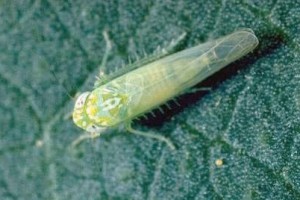Potato Leafhopper
 Scientific Name
Scientific Name
Empoasca fabae
Host
Potato leafhoppers feed on more than 200 cultivated and wild plants. In addition to fruit trees and forage crops, vegetables such as beans, potatoes, eggplant, and rhubarb are subject to infestation.
Symptoms
 Both nymphs and adults feed on the undersides of leaves. By extracting sap, they cause
stunting of plants, curling of leaf margins, and crinkling of the upper surface of
leaves. While feeding, leafhoppers also inject a toxic substance into plants which,
in most vegetable hosts, causes a condition known as "hopper-burn." This condition
is characterized by a yellowing of the tissue at tips and margins of leaves which
increases until the leaves die. Symptoms of leafhopper damage are sometimes confused
with drought stress.
Both nymphs and adults feed on the undersides of leaves. By extracting sap, they cause
stunting of plants, curling of leaf margins, and crinkling of the upper surface of
leaves. While feeding, leafhoppers also inject a toxic substance into plants which,
in most vegetable hosts, causes a condition known as "hopper-burn." This condition
is characterized by a yellowing of the tissue at tips and margins of leaves which
increases until the leaves die. Symptoms of leafhopper damage are sometimes confused
with drought stress.
Life Cycle
This insect overwinters in the Gulf Coast states and migrates into Oklahoma in the spring or early summer. Large numbers of flying adults often appear suddenly in fields soon after the plants come up. Beginning 3 to 10 days after mating, females use their sharp ovipositors to insert eggs into the main veins or petioles of leaves. Each female lives a month or more and produces 2 or 3 eggs per day. Eggs hatch in about 10 days and the nymphs mature in about 2 weeks. Nymphs usually mature on the leaves where they hatched. Mating occurs about 48 hours after maturation and the life cycle is repeated. There are three or four generations per year.
Description
The adult is small, green, wedge-shaped, and about 1/8 inch long. There are a number of small, pale yellowish or white spots on the body. The hind legs are long and enable the insect to jump a considerable distance. The nymphs (immature insects) are similar in shape to the adults but lack wings. They are pale green in color.
Control
Please contact your local county extension office for current information.
